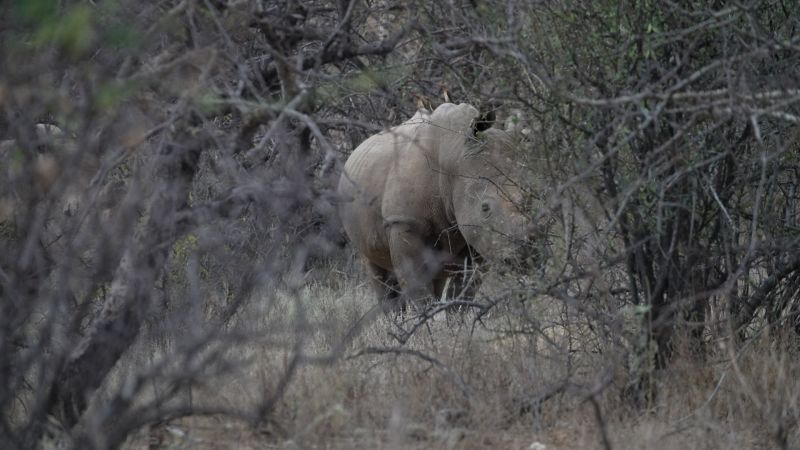It’s early morning in Sera Community Conservancy in Northern Kenya and sunlight beats down across this expansive semi-arid landscape. Birds calling and boots crunching are the only sounds for miles as a team led by Kenyan wildlife veterinarian Dr. Mukami Ruoro-Oundo carefully tracks white rhinos — the first of their kind to be found here in Samburu County.
Once common in the area, by the early 1990s Northern Kenya’s rhino population was decimated by poaching. But the country’s black rhino population has more than doubled since 1989, and by December 2022 there were 1,900 black rhinos and white rhinos in total, according to Kenya Wildlife Services.
Sera Conservancy has championed the country’s community-led rhino conservation efforts. In 2015 it established East Africa’s first community rhino sanctuary with the introduction of 10 critically endangered black rhinos. Today, that number has grown to 21 black rhinos which freely roam across 107 square kilometers (41 square miles) of designated sanctuary land, and in February 2024, they were joined by four white rhinos from the nearby Lewa Conservancy.
As she searches on foot, Dr. Ruoro-Oundo spots two of the female white rhinos. One, called Sarah, looks heavily pregnant but as the vet creeps closer she notices something is very wrong.
Mindful of not encroaching too long on the rhinos’ territory and reluctant to intervene unnecessarily, she opts for a different approach; through a conservation technology tool called EarthRanger she can monitor Sarah’s movements in real time from a distance.
Prior to translocation, each of the four white rhinos was fitted with a GPS tag in its horns and ears, which sends a real-time location to remote devices like mobile phones, or to the conservancy’s operations center, where Dr. Ruoro-Oundo is able to monitor Sarah’s location and movements.
Sparse internet connectivity means Dr. Ruoro-Oundo cannot get a clear signal from Sarah’s transmitter but thankfully Sarah is not alone; a female rhino named Arot has never left her side and through Arot’s transmitter Dr. Ruoro-Oundo can see that Sarah has barely moved in hours, suggesting her condition is deteriorating. By using a drone to take photos of her, the team is able to confirm that Sarah urgently needs help.
“We noticed she has a fecal impaction, it was quite huge and had made the rectal and vulvar area swollen,” says Dr. Ruoro-Oundo. “She’s in a lot of pain because she could not put down her tail, and you could see she was a bit sluggish, she really wanted to spend her time lying down. So in such a case we really need to intervene for her comfort, to relieve her of the distress and the pain.”
An emergency intervention is immediately put into action, led by Kenya Wildlife Services and Sera Conservancy’s management and rangers. Air, ground and additional veterinary support are mobilized within hours — potentially saving not only Sarah’s life but that of her unborn calf too.
For Dr. Ruoro-Oundo, the key to safeguarding Kenya’s wildlife is a balance between community and technology.
“I think you cannot separate technology from conservation in the future,” she says.” The human element can never be removed, but technology will always come to assist where we cannot reach.”
A global effort
Now used in 70 countries, EarthRanger’s story started in Kenya when co-founder Wall was researching elephants there.
“In about 2012, we had a real crisis with poaching in Kenya, so we wanted a way that we could pick up on elephants that were getting killed, and the sign for us was that the collar stopped moving for more than about five or six hours, which is the longest sort of period that an elephant rests for,” he recalls.
“So I wrote the algorithm that could work out whether an elephant had stopped moving or not, and then (the collar) would send an SMS if it had. So that was kind of the beginning.”
He adds that the system has evolved quite significantly since then, and Sarah is one of 9,000 animals — including elephants, lions, giraffe, tortoises, sea turtles and 1,200 rhinos — that EarthRanger is currently tracking in Kenya alone.
Wall says the system can integrate data from more than 100 different devices — “anything from elephant trackers to ear tags for rhino, to collars for lions, tail tags (for giraffes), devices that glue onto the shell of a turtle.”
It can also receive information from sources such as vehicle trackers, satellites, and remote sensing alerts for things like deforestation and fire. “It’s pulling it all into one platform, where it can be readily visualized, analyzed and then acted upon,” Wall adds. “And all of that’s giving the operators and managers a bird’s eye view of the situation as it’s happening, with real-time tools.”
According to the EarthRanger, all of these devices are designed to be lightweight, durable and inconspicuous ensuring they don’t impact on the animals’ natural behavior or cause them discomfort. For rhinos, Dr. Ruoro-Oundo says that attaching a tracker is the equivalent sensation of a human getting their ears pierced.
Samuel Lekimaroro, a wildlife protection manager for the Northern Rangelands Trust, which includes Sera Conservancy, uses this kind of data to live-track terrestrial and marine wildlife across 6.5 million hectares. For Lekimaroro it has become a powerful tool in translocating wildlife, data collection and security operations, including identifying hotspots for human-wildlife conflict.
“Thanks to EarthRanger, trophy poaching has been on a steady decline for the last five years, from a high of 120 elephants poached in 2012, to zero in the last four years in (our) member conservancies,” he says.
Wall says its potential to securely collect and share data from different EarthRanger sites from across the world is revolutionary.
“If organizations are doing, say, joint patrolling, or monitoring of a species, then they can also share that information,” he says. “By storing information on EarthRanger we can pull that data from different sites and combine it in ways that was never possible before. So it’s really enabling the analysis and the reporting in a way that just never existed before.”



























